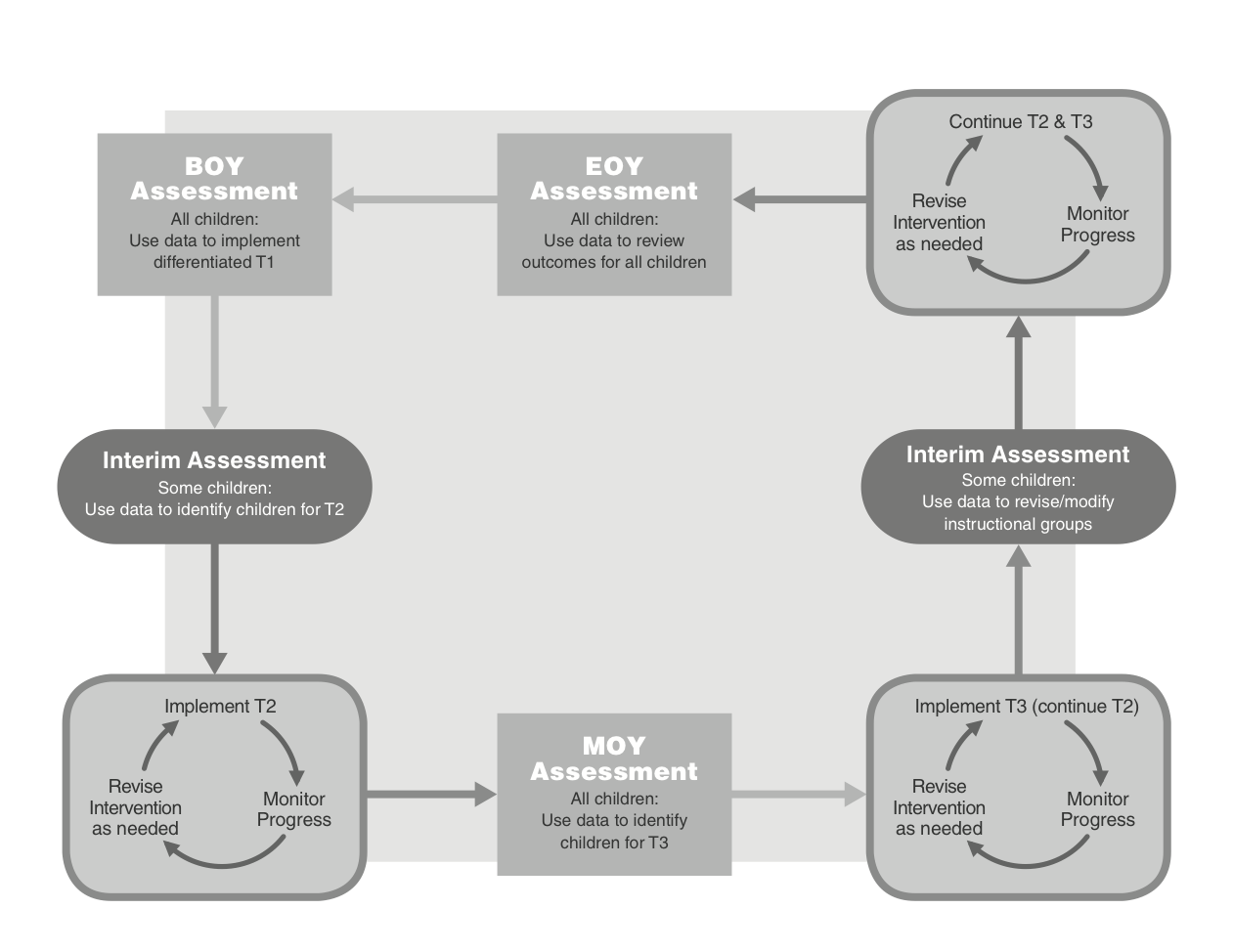Impacting Literacy Outcomes: A Model for Providing Effective Tier 3 Intervention in Preschool
Response to Intervention (RTI) and Multitier Systems of Support (MTSS) are models of service delivery increasingly adopted by early childhood settings for prevention of later academic difficulties. In RTI/MTSS service delivery models, high-quality teaching is provided to young children using a data-based, decision-making process to differentiate support for all children according to their level of and diverse learning needs. A common RTI/MTSS model is a three-tiered model. In a three-tiered model, Tier 1 consists of whole-class instruction with a high-quality curriculum. Tier 2 is typically small-group instruction designed to provide extra support to children to address specific learning needs. Tier 3 support is more intensive, often individualized, intervention for children who demonstrate significant learning needs.
As a service delivery model, RTI/MTSS is complex, consisting of multiple components and moving parts. Among the components, Tier 3 is one of the most challenging to implement. There is little research specific to Tier 3 intervention in early childhood settings and there are many more questions than answers, including: Which young children are appropriate candidates for Tier 3 support? How do we identify children in preschool who need Tier 3 support? What are the features of effective Tier 3 support in early childhood? How can Tier 3 intervention be implemented in the variety of early childhood settings? What about early childhood special education?
Whether or not Tier 3 intervention is even warranted at the preschool level is an important consideration to address. After all, many children in preschool may not yet have had the opportunity to benefit from learning opportunities. Because of this, some believe providing intensive intervention at preschool is intrusive and unnecessary. I disagree with this perspective and suggest that providing Tier 3 support as early as is practical in the preschool years is critical to fostering later school success, especially for preschool children with the lowest skills. Longitudinal research clearly shows that the skills children enter kindergarten with make a substantial contribution to later academic success. In addition, children who start their preK year in a typical early childhood program with skills that are below average rarely catch up without some type of intensified instruction. Finally, there is a substantial body of converging evidence that supports there are larger effects for interventions provided in the early stages of reading acquisition than for interventions provided in third grade and higher.
Early Childhood Adaptation of Outcomes-Driven Model
Of course, a key element of screening for identification of children who need support is the use of a reliable-and-valid measure that is appropriate for screening and progress monitoring of preschool children. Within the Outcomes-Driven Model framework, an appropriate, reliable, and valid screening measure is administered to all children three times during the course of the year—at the beginning, middle (MOY), and end of the year (EOY). At the beginning, the initial screening can serve as a guide for differentiating instruction for all children in Tier 1. The BOY scores also serve as a baseline from which to gauge progress during the first few weeks and months of school. Then, midway between the beginning and middle of the year, approximately 6 weeks to two months after the initial screening, I recommend conducting an interim assessment which can serve as a progress checkup for children who demonstrated low skills initially along with any other children with areas of concern. These data from the interim checkup let us know which children are and are not making progress when provided with the Tier 1 classroom instruction. Other information collected during the course of the first few weeks and months of school such as anecdotal records and classroom observations can then be used along with the interim progress information to further differentiate core instruction. Teachers may begin to provide small group Tier 2 instruction at this time for the group of children who are not making adequate progress. I would recommend that for these children, teachers also begin more frequent progress monitoring in the specific skill areas that are the focus of the small-group instruction.
At the middle of the year, all children will again be screened. These MOY data provide information regarding which children are making progress in Tier 1 and Tier 2. Teachers may begin Tier 3 intervention at this time for those children who have not made adequate progress in Tier 1 and/or Tier 2 in the first half of the school year. Starting Tier 3 intervention no later than the middle of the year allows for approximately 20 weeks of intervention to accelerate children’s development of critical early literacy and language skills. My experience conducting research on Tier 3 interventions in preschool indicates that eight weeks of intervention was enough time to accelerate growth for some children, but was not enough time for all children.
As we think about implementing Tier 3 interventions in preschool, it is important to draw attention to the fact that not all children will need to go through Tier 2 to get to Tier 3. This has been found to be true in RTI/MTSS implementations in early elementary grades and I support this recommendation in preschool. The purpose of RTI/MTSS in preschool is to prevent later reading and academic problems. Some young children will demonstrate significant delays and lack of progress despite a generally effective Tier 1 such that it makes the most sense to move directly to a more intensive Tier 3 intervention. It is also important to emphasize that Tier 3 is not synonymous with early childhood special education. Children receiving Tier 3 support in a particular skill area (e.g., early literacy, language, social emotional/behavioral) may or may not have identified disabilities in that domain. Further, children with identified disabilities may be appropriately served in Tier 1 and/or Tier 2 depending upon their individual learning needs.
The implementation of an effective Tier 3 intervention will require the use of instructional strategies that are more explicit, systematic, and individualized than small-group Tier 2 instruction. Consequently, implementation of Tier 3 intervention in preschool requires thoughtful planning and strategic classroom management in addition to carefully designed instruction. In early literacy and language, the most effective interventions are likely to be ones that combine highly focused, small-group/one-on-one instruction with intentional embedded approaches. Such integrated approaches maximize the effectiveness and efficiency of teaching and learning by providing opportunities for children to receive the individualized instruction needed to acquire new skills combined with opportunities to practice, apply, and generalize the skills in multiple contexts across the preschool day.
Preschool provides a critical window of opportunity to accelerate learning for young children with the most significant learning needs. By intensifying earlier rather than waiting until these children get to elementary school, we may significantly decrease the numbers of children who struggle academically later in school.
References
Catts, H.W., Nielsen, D.C., Bridges, M.S., Liu, Y.S., & Bontempo, D.E. (2015). Early identification of reading disabilities within an RTI framework. Journal of Learning Disabilities, 48(3), 281-297.
Compton, D.L., Gilbert, J.K., Jenkins, J.R., Fuchs, D., Fuchs, L.S., Cho, E., Barquero, L.A., & Bouton, B. (2012). Accelerating chronically unresponsive children to tier 3 instruction: What level of data is necessary to ensure selection accuracy? Journal of Learning Disabilities, 45(3), 204-216.
Good, R. H. III, Kaminski, R. A., Cummings, K. D., Dufour-Martel, C., Petersen, K., Powell-Smith, K. A., Stollar, S., & Wallin, J. (2021). Acadience Reading K-6 Assessment Manual. Dallas, TX: Voyager Sopris Learning.
Greenwood, C.R., Carta, J.J., Atwater, J., Goldstein, H., Kaminski, R., & McConnell, S. (2012). Is a response to intervention (RTI) approach to preschool language and early literacy instruction needed? Topics in Early Childhood Special Education, 33(1), 48-64.
Kaminski, R. A., Abbot, M., Aguayo, K.B., and Good, R.H. (2021). Acadience Reading Pre-K: PELI Assessment Manual. Dallas, TX: Voyager Sopris Learning.
Kaminski, R.A., Abbott, M., Bravo Aguayo, K., Latimer, R., Good, R.H. (2014) The Preschool Early Literacy Indicators: Validity and benchmark goals, Topics in Early Childhood Special Education, 34(2), 71-82.
Kaminski, R. A., & Powell-Smith, K. A. (2016). Early literacy intervention for preschoolers who need tier 3 support. Topics in Early Childhood Special Education. Advance online publication. doi: 10.1177/0271121416642454
Kaminski, R.A., Powell-Smith, K.A., & Aguayo, K.B. (2019). Creating and providing Tier 3 instructional support. In J.J. Carta & R.M Young (Eds.) Multi-tiered systems of support for young children: Driving change in early education. Baltimore: Brookes.
Kaminski, R. A., Powell-Smith, K. A., Hommel, A., McMahon, R., & Bravo Aguayo, K. (2015). Development of Tier 3 curricula to teach early language and literacy skills. Journal of Early Intervention, 36, 313–332.
National Early Literacy Panel. (2008). Developing early literacy: Report of the National Early Literacy Panel. Washington, DC: National Institute for Literacy.
Wanzek, J., & Vaughn, S. (2008). Response to varying amounts of time in reading intervention for students with low response to intervention. Journal of Learning Disabilities, 41(2), 126-142.



